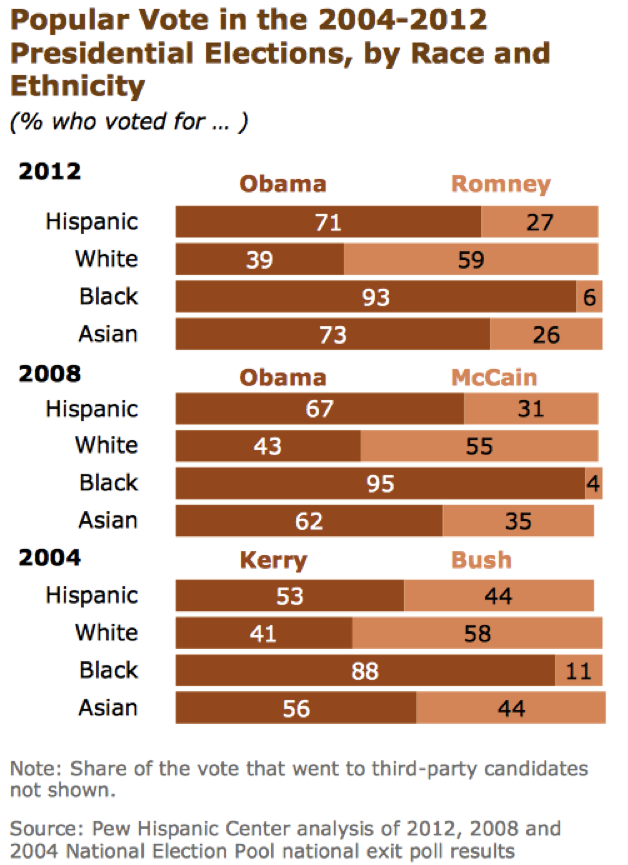In the increasingly crowded GOP primary field, there are three candidates who have something that all Republicans want, and few can claim: a plausible path to making a substantial connection with Hispanic voters. They are, or course, Florida Sen. Marco Rubio, Texas Sen. Ted Cruz, and former Florida Governor Jeb Bush.
Cruz and Rubio are both children of Cuban immigrants, who can tell a story about realizing the American Dream. Bush has a more complicated narrative. Having been born into one of the first families of American politics, he married a Mexican woman, speaks fluent Spanish, and has proven himself willing to buck anti-immigration hardliners within his party.
Related: With Credibility Slipping, Clinton Pushes Back on Benghazi Probe
The GOP has had trouble capturing anything beyond a small slice of the growing Latino vote. The last Republican to win the Presidency, George W. Bush, did so by capturing 44 percent in the 2004 election. In the years since, the Republican share of the Hispanic vote has dwindled. John McCain won 31 percent in 2008, and Mitt Romney took only 27 percent in 2012.

Recapturing the same level of Hispanic support that George W. Bush enjoyed is central to any successful Republican presidential bid, said Whit Ayres, a Republican pollster and author of a new book, 2016 and Beyond: How Republicans Can Elect a President in the New America.
Ayres, who is working for Marco Rubio, said it’s obvious that Hispanics are the fastest growing minority group in the country and will hold increasing influence with every passing presidential election, especially in a number of swing states like Florida, Nevada, Colorado, New Mexico, Arizona and ultimately Texas. “So gaining a significantly larger share of the Hispanic vote than Mitt Romney was able to do in 2012 will be absolutely critical for any Republican nominee in 2016,” he said in an interview Tuesday.
Ayres said that Republicans would need close to a majority – at least 45 percent of the Hispanic vote -- to win. So being able to identify closely with the Hispanic community is a major asset to a Republican contender.
That won’t be easy, says University of Virginia political scientist Larry Sabato. “Hispanics lean heavily to the Democratic party in a polarized age when party identification matters greatly. Turnout may be the key for the GOP. Are Hispanics energized (2012) or not energized (2014) to show up at the polls?”
Can Any GOP Candidate Carry the Day?
Of the three candidates who can tell Hispanic voters a story that might just resonate, how do they stack up?
It’s probably best, up front, to dispense with Ted Cruz. The only one of the three who doesn’t speak Spanish, Cruz is a hardliner on immigration and, according to most analysts, isn’t likely to inspire much loyalty among Latino voters.
Related: U.S. Hispanic Voters Likely to Double by 2030
“At least right now, Ted Cruz is one of those candidates who has no idea what it means to appeal to Latino voters,” said Cesar Vargas, co-director of the Dream Action Coalition, which advocates for undocumented immigrants. “He’s just offering very transparent sound bites about how Latino voters value the family. We obviously love our families, but Latino voters are asking ‘What are you doing to help our families?’”
Amy Walter, national editor of the Cook Political Report, was more succinct. “Ted Cruz?” she said. “He’s not even trying.”
Rubio, the son of Cuban immigrants, has made his life story a cornerstone of his campaign. His father, a hotel bartender, and his mother, a hotel maid, raised him mainly in South Florida. He became a lawyer, rose quickly through the Florida legislature, and jumped to the United States Senate before his 40th birthday.
Rubio made a name for himself on immigration issues by joining the “Gang of Eight” senators who proposed a comprehensive immigration reform bill in 2013. The bill died in the Senate, and Rubio had to walk back his support for it in the face of withering attacks from the anti-immigration right.
However, according to Vargas, the mere fact that he tried carries a lot of meaning. “He showed he was willing to take on a fight,” he said.
Related: Will an Overcrowded Field Ruin the GOP’s Chances in 2016?
Bush has also demonstrated that he is willing to push back against the most anti-immigration elements of the GOP. He memorably described illegal immigration as an “act of love” by individuals trying to better their families’ lives. Of course, politicians looking to secure the Latino vote need to address other issues as well said Clarissa Martinez-De-Castro, the deputy vice president of the National Council of La Raza.
“Immigration is not the only issue that Hispanics care about,” she said on MSNBC, but it is one that Hispanic voters are watching very carefully in assessing the candidates. As for the relative appeal of Jeb Bush, Rubio and Cruz, she said, “Latinos have shown in many elections in the past that they are willing to look at candidates based on their positions, regardless of what party they belong to.”
Ayres agreed that while Hispanics are more concerned about bread and butter economic issues than immigration, “Immigration is a threshold issue – it’s a symbolic issue that sends a signal to Hispanics that we do or do not want you as part of the center-right coalition.”
Related: Carson and Fiorina – Two Ankle Biters Join the GOP Pack
Any Republican who gets the nomination has to confront the fact that the GOP faces a terrible map in presidential elections. Democrats start out with a sizeable advantage in terms of reliably Democratic states. The big question is whether a Republican candidate able to move a significant fraction of the Hispanic vote into the GOP’s column would, by doing so, be able to flip important swing states.
“It’s absolutely achievable,” says Walter of the Cook Political Report. “Look at Colorado, Virginia, Nevada – three states where the population growth and the shift in terms of its movement from Republican-leaning to Democrat leaning states has really been among Latino voters. Even North Carolina could be another place.” She said, “You win enough of the Hispanic vote, that’s going to pick you up Colorado, Nevada, Virginia, and North Carolina. You win those, you’re probably president of the United States.”
Ayres agree that it’s doable, adding that Florida – where Rubio and Bush both have the advantage of being de facto native sons – is also necessary. “Florida is absolutely critical for building a Republican majority in the Electoral College,” he said. “Texas is as well but it’s more likely to fall into the Republican Party by the natural course of human events.”
Related: GOP’s Iffy Future as Hispanic Population Grows
Ayres said George W. Bush set the model in 2004 when he won 26 percent of the non-white vote overall and 44 percent of the Hispanic vote. He reached out very aggressively to Hispanic voters and also supported reforming a broken immigration system. “That is not sufficient to win Hispanic votes, but it’s pretty hard to gain a significant share of the Hispanic vote if your position is that you want to deport 11 million Hispanics,” he said, referring to Mitt Romney’s position in the 2012 election.
Sylvia Manzano, an official with Latino Decisions, a polling and advocacy group, agrees that the Republican Party and conservative groups have been aggressive this year in reaching out to Hispanic voters in an effort to reverse the recent trends, and that a “good chunk” of the Latino vote may be up for grabs in the 2016 general election campaign.
“The difficulty for the [Republican] party is that the party has invested resources in this go-round, but they also are kind of stuck with people who have been really hostile and have said some pretty inflammatory things in the immigration discourse and supported really punitive policies,” she said. “So that’s a difficult thing for the candidates to do – to distance themselves from the [controversial Sheriff] Joe Arpaio of Arizona or Rep. [Steve] King of Iowa. . . . That’s a difficult dance for them to do.”
Top Reads from The Fiscal Times:





